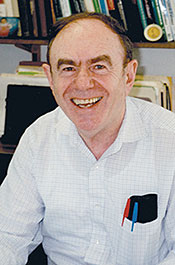Arthur J. Freeman
DOI: 10.1063/PT.3.3373
Arthur J. Freeman, a professor emeritus in the department of physics and astronomy at Northwestern University, died on 7 June 2016 in Brookline, Massachusetts. He was a pioneering developer of computational quantum materials science; based on density functional theory, its methods are used in high-performance computers to simulate new materials via virtual fabrication.

Arthur J. Freeman

Born in Lublin, Poland, on 6 February 1930, Art went to the US at age 7 with his three siblings. He earned his undergraduate, graduate, and PhD degrees in physics from MIT. His PhD, which he received in 1956, was done under the direction of John Slater; his thesis was titled “The electronic energy of the OH molecule.” He then worked at Brandeis University and the US Army Materials Research Agency. He started at the MIT National Magnet Laboratory in 1962 and soon became its first associate director before going to Northwestern University in 1967.
Art received Guggenheim, Fulbright, and Alexander von Humboldt fellowships, and in 1990, in recognition of “his pioneering achievements in the field of monolayer and low dimensional magnetism,” the Materials Research Society presented him with the first MRS Medal. He was also the first recipient of the International Union of Pure and Applied Physics Magnetism Award in 1991. Art was the founding editor-in-chief of the Journal of Magnetism and Magnetic Materials. As author or coauthor on more than 1000 publications, he is one of the top 20 most-cited physics researchers worldwide.
Art and his coworkers made seminal contributions to a fundamental school of thought in condensed-matter physics. Known as predictive atomistic theory of real solids, it was a continuation of the works of Slater, Enrico Fermi, Walter Kohn, and Marvin Cohen, among others. From the chemical identity and arrangement of a material’s constituent atoms, the approach makes predictions about the material’s properties. As part of the theory, the Hamiltonian characteristically includes the elementary interactions that set up the interatomic “glue,” and its solution provides the basic constants for the specific system at hand, with the number and range of interactions decided by the underlying Hamiltonian, not by the user. It includes forces for geometry optimization and calculation of mechanics, force constants for lattice-dynamics calculations, spin–spin interactions for Heisenberg-based magnetism calculations, and atom–atom pair interactions for Ising-based temperature–composition phase-diagram calculations. The basic insight is that structure and composition define the platform for understanding physical properties and functionality.
Considered to be the father of the full-potential, linearized augmented plane-wave (FLAPW) method, Art, with his associates, developed the most accurate realization of the density functional approach. The all-electron technique allows for a full range of interactions, such as exchange, including screened exchange; spin–spin, including nucleon spin; spin–orbit; and electron–photon, including x rays. The FLAPW method is used worldwide for studies of the structural, electronic, magnetic, and linear and nonlinear optical and mechanical properties of metals, semiconductors, insulators, and nanostructures.
Art and his colleagues consistently introduced paradigm changes—for example, shattering the belief in the free-electron model of rare-earth optical and electronic properties in the 1960s—and they ushered in the modern transition-metal viewpoint. With his coworkers, Art redefined our understanding of the nature of the light actinide metals in terms of f-bands rather than localized levels. They explained that the seminal issue of the counterintuitive sign of the hyperfine interaction measured in Mössbauer spectroscopy arose from the core polarization. Their predictions of enhanced magnetic moments at surfaces and interfaces inspired widespread searches for new magnetic surface phenomena and debunked the belief in magnetic dead layers. Their work on oxide superconductors highlighted the importance of the layering of metallic and insulating planes in controlling the normal-state electronic properties.
Art was an international ambassador of science. He trained and mentored more than 50 visiting scholars, postdocs, and graduate students from Asia— particularly Japan, China, and South Korea—and from Europe. Many of them have become leaders in their home countries and have made significant contributions in computational materials science, physics, and chemistry.
Art will be remembered by his students and associates the world over as a prolific scientist of great drive and insight; as a devoted husband, father, and stepfather; and as a warm and caring person to everyone around him.
More about the Authors
Sam Bader. Argonne National Laboratory, Lemont, Illinois.
Bruce Harmon. Iowa State University, Ames Laboratory, Ames.
Ivan Schuller. University of California, San Diego, La Jolla.
Ruqian Wu. University of California, Irvine.
Alex Zunger. University of Colorado Boulder.




